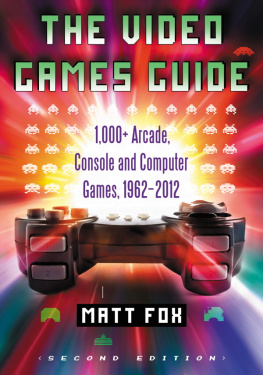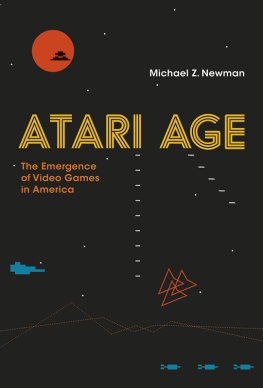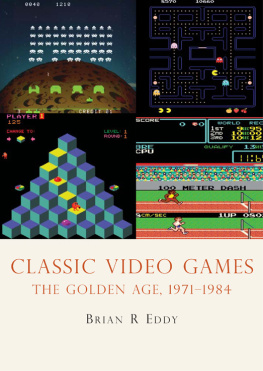GAMING:
FROM ATARI TO XBOX
COMPUTING AND CONNECTING IN THE 21ST CENTURY
GAMING:
FROM ATARI TO XBOX
EDITED BY MICHAEL RAY, ASSISTANT EDITOR, GEOGRAPHY AND POPULAR CULTURE

Published in 2012 by Britannica Educational Publishing
(a trademark of Encyclopdia Britannica, Inc.)
in association with Rosen Educational Services, LLC
29 East 21st Street, New York, NY 10010.
Copyright 2012 Encyclopdia Britannica, Inc. Britannica, Encyclopdia Britannica,
and the Thistle logo are registered trademarks of Encyclopdia Britannica, Inc.
All rights reserved.
Rosen Educational Services materials copyright 2012 Rosen Educational Services, LLC.
All rights reserved.
Distributed exclusively by Rosen Educational Services.
For a listing of additional Britannica Educational Publishing titles, call toll free (800) 237-9932.
First Edition
Britannica Educational Publishing
Michael I. Levy: Executive Editor
J.E. Luebering: Senior Manager
Adam Augustyn: Assistant Manager, Encyclopdia Britannica
Marilyn L. Barton: Senior Coordinator, Production Control
Steven Bosco: Director, Editorial Technologies
Lisa S. Braucher: Senior Producer and Data Editor
Yvette Charboneau: Senior Copy Editor
Kathy Nakamura: Manager, Media Acquisition
Michael Ray: Assistant Editor, Geography and Popular Culture
Rosen Educational Services
Jeanne Nagle: Senior Editor
Nelson S: Art Director
Cindy Reiman: Photography Manager
Amy Feinberg: Photo Researcher
Brian Garvey: Designer, Cover Design
Introduction by Michael Ray
Library of Congress Cataloging-in-Publication Data
Gaming: from Atari to Xbox/edited by Michael Ray.
p. cm.(Computing and connecting in the 21st century)
In association with Britannica Educational Publishing, Rosen Educational Services.
Includes bibliographical references and index.
ISBN 978-1-61530-736-4 (eBook)
1. Video games. 2. Computer games. I. Ray, Michael.
GV1469.3.G427 2012
794.8dc23
2011035886
On the : An early Atari game console (top) with (left to right) game cartridges and a paddle controller, which was wired to the console. SSPL via Getty Images. An Xbox 360 console (bottom) with a Kinect motion detector camera (left) and wireless controller (right). Barone Firenze/Shutterstock.com
On pages -xi: Visitors play Sony Xbox 360 games at the 2006 Electronic Entertainment Expo in Los Angeles. Robyn Beck/AFP/Getty Images
Cover (background), pp. www.istockphoto.com/Simfo; remaining interior background image www.istockphoto.com/Johan Ramberg
CONTENTS












INTRODUCTION

In little more than half a century, electronic games have evolved from novel curiosities created by university computer science departments to a multi-billion-dollar global entertainment phenomenon. Iconic game characters such as Pac-Man, Mario, and Lara Croft have achieved a level of name recognition on par with celebrities and historical figures. Successful games can generate more revenue in a single day than a major Hollywood movie can during its entire box office runand several games have themselves been made into movies.
This evolution did not happen in a vacuum, however. The popularity of electronic games has ebbed and flowed for a number of reasons. Players have shifted from the arcade to home consoles, from personal computers to handheld devices, as technological advances or killer apps (games that are desirable enough to inspire a player to purchase an entirely new gaming system) have made different platforms more appealing. Improved graphics and portability differentiate the latest generation of consoles from their predecessors, but the ability to compete or cooperate with other human players over a network has restored a social element to electronic gaming that recalls the earliest video arcades.
There has also been a divergence in the perceived target audience of electronic games. Traditionally, video games had been dismissed as a plaything of young boys. Over time, it became apparent that men and women of every age were enjoying electronic games, and the market responded accordingly. Family friendly fare, such as the party games commonly found on the Nintendo Wii, appealed to a broad demographic; the widespread success of that system indicated that the Wiis programmers had hit their mark. Conversely, games specifically targeting a mature audience, such as the Grand Theft Auto franchise, posted strong sales with stories that featured sexual situations, violence, and emotionally complex characters who would not have been out of place in a well-written R-rated film.
The creation of such a diverse catalog of games could not have been foreseen when William Higinbotham created Tennis for Two in 1958. Intended as a technology demonstration for visitors to Brookhaven National Laboratory in New York, the game was played on an analog computer, using an oscilloscope as a screen. Tennis for Two featured simple controlsa rotating dial varied the angle of the players racquet, and a single button dictated the timing of serves and volleys. The game was an immediate hit, as spectators gathered around the five-inch display to watch as a glowing dot (representing the ball) bounced back and forth across the simulated tennis court. The following year, programmers replaced the small display with a larger screen and added gameplay options that allowed players to simulate tennis in a low-gravity environment (such as the Moon) or a high-gravity environment (such as Jupiter).
A few years later and a short distance away, a group of young programmers at Massachusetts Institute of Technology were exploring the capabilities of Digital Equipment Corporations new Programmed Data Processor (PDP) minicomputer. DEC had donated a PDP-1 to MIT, and students were eager to demonstrate what the machine could do. Weighing more than half a ton, measuring 8 feet (2.4 metres) tall and 6 feet (1.8 metres) wide, and outfitted with a 16-inch CRT display and Soroban typewriter that had been modified to act as an input/output device, the PDP-1 was the state of the art in laboratory computing. With a price tag of $120,000, programmers frequently added the prefix Expensive to describe PDP-1 program functions; for example, Expensive Typewriter replicated the function of a standard electric typewriter at roughly a thousand times the cost. Expensive Planetarium was a slowly scrolling star map created by MIT student Peter Samson.
Next page











![Mark J. P. Wolf (editor) - Encyclopedia of Video Games: The Culture, Technology, and Art of Gaming [3 volumes]](/uploads/posts/book/279290/thumbs/mark-j-p-wolf-editor-encyclopedia-of-video.jpg)

















